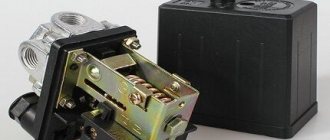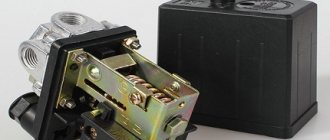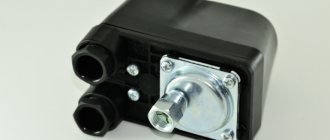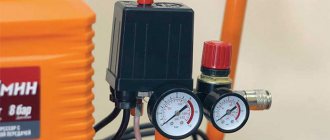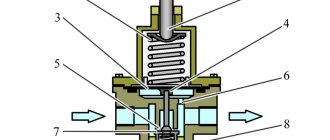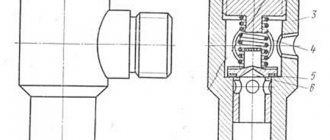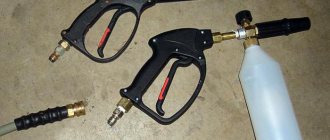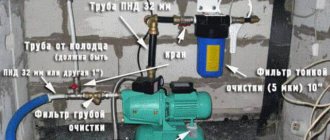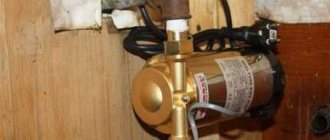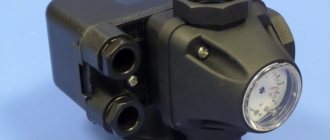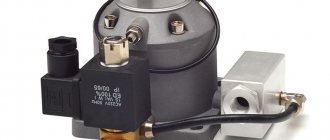The use of an air pneumatic relay allows you to automate the filling of the compressor receiver with compressed gas. The operator of equipment with a pressure switch does not need to monitor the process, trying to fix the limit parameters. As a result, engine damage is prevented. Significant results, right?
If you are planning to purchase a pressure switch for your compressor, then you have come to the right place. Here you will find a vast amount of extremely useful information about the principles of operation of the device, its configuration and connection methods.
We have described in detail the existing types of pneumatic relays. They provided options for connecting to a household and industrial network with extremely clear diagrams. We looked at typical breakdowns and ways to prevent them. The information and useful tips we provide are supplemented with graphic, photo and video applications.
Operating principle of a pressure switch
The name of the relay is determined by its purpose - controlling a piston compressor to maintain the required atmospheric pressure in the receiver. It is rarely found on a screw type device responsible for compressing and supplying air.
I take into account the magnitude of the pressing force in pneumatic automation; the device acts on the voltage line, closing or opening it. Thus, insufficient pressure in the compressor starts the motor, and when the required level is reached, it turns it off.
This standard operating principle, based on connecting a normal closed loop to a circuit, is used to control the motor.
The design of all ejectors contains a cylinder containing air at a certain pressure. Reducing it requires turning on the engine to replenish the supply. If the situation is the opposite and an excess is detected, the supply is stopped so that the container does not burst. These processes are controlled by a pressure switch
Modifications with the opposite operating algorithm are also presented: when reaching minimum values in the compression circuit, the pressure switch turns off the electric motor, and at maximum values it activates. Here the system operates in a normally open loop.
The operating system is made up of spring mechanisms with varying degrees of rigidity, reproducing the response to fluctuations in the air pressure unit.
During operation, the indicators formed as a result of the elastic force of tension or compression of the springs and the pressure of the atmosphere pressed by the device are compared. Any changes automatically activate the action of the spiral and the relay unit connects or disconnects the electricity supply line.
However, it is worth considering that the design of the review model does not provide for regulatory influence. Exceptional impact on the engine. In this case, the user has the opportunity to set a peak value, upon reaching which the spring will fire.
Conclusions and useful video on the topic
Details about the design of the pressure switch, as well as a visual process for adjusting its parameters in the plot:
It is also possible to independently assemble the control unit for the compressor; see this video:
Pneumatic devices are considered safer and easier to use than electric or gasoline models. There is a wide selection of additional equipment that works with compressed air: guns for washing, inflating tires or painting and many others.
With the help of a relay, it becomes possible to operate automatically while maintaining the required compression level in the receiver.
Please write comments in the block form located under the article test. Share your own experience in operating a compressor with a pressure switch, ask questions, post photos on the topic. It is possible that your recommendations will be useful to site visitors.
One of the main indicators of air compressors is operating pressure. In other words, it is the level of air compression created in the receiver that must be maintained within a certain range. It is inconvenient to do this manually, referring to the indicators of the pressure gauge, so the compressor automation unit is responsible for maintaining the required level of compression in the receiver.
Complete set of compressor automation unit
The relay design is a small-sized block equipped with receiving pipes, a sensing element (spring) and a membrane. Mandatory subassemblies include an unloading valve and a mechanical switch.
The pressure switch sensing unit is made up of a spring mechanism, the compression force of which is changed by a screw. According to the factory standardized settings, the elasticity coefficient is set to a pressure in the pneumatic chain of 4-6 at, as reported in the instructions for the device.
Inexpensive models of ejectors are not always equipped with relay automation since such devices are mounted on the receiver. However, during long-term operation, to eliminate the problem of overheating of engine elements, it makes sense to install a pressure switch
The degree of rigidity and flexibility of the spring elements is subject to the temperature of the environment, therefore absolutely all models of industrial devices are designed for stable operation in an environment from -5 to +80 ºC.
The reservoir membrane is connected to the relay switch. During movement, it turns the pressure switch on and off.
The unloading unit is connected to the air supply line, which allows excess pressure to be released into the atmosphere from the piston compartment. This relieves the moving parts of the compressor from excessive force.
The unloading element is located between the ejector check valve and the compression block. If the motor drive stops working, the unloading section is activated, through which excess pressure (up to 2 atm) is released from the piston compartment.
With further start or acceleration of the electric motor, a pressure is created that closes the valve. This prevents overloading of the drive and simplifies starting the device in switched off mode.
There is an unloading system with a time interval of activation. The mechanism remains in the open position when the engine starts for a specified period. This range is enough for the engine to achieve maximum torque.
A mechanical switch is required to start and stop the automatic system options. As a rule, it has two positions: “on.” and "off". The first mode turns on the drive and the compressor operates according to the established automatic principle. The second one prevents accidental starting of the engine, even when the pressure in the pneumatic system is low.
Shut-off valves allow you to avoid emergency situations when elements of the control circuit fail, for example, a breakdown of the piston unit or a sudden stop of the motor
Safety in industrial structures must be at a high level. For these purposes, the compressor regulator is equipped with a safety valve. This ensures system protection in case of incorrect relay operation.
In emergency situations, when the pressure level is higher than the permissible norm, and the telepressostat does not work, the safety unit comes into operation and vents the air. Safety valves in heating systems operate according to a similar scheme, the operating principles and devices of which are described in the article we recommend.
Optionally, a thermal relay can be used as additional protective equipment in the review device. With its help, the strength of the supply current is monitored for timely disconnection from the network when parameters increase.
To avoid burnout of the motor windings, the power is turned off. The nominal values are set using a special control device.
What is a pressure switch?
Pressostat is a pressure switch for a compressor, the main component of compressor automation. He is responsible for starting and stopping the system if it reaches the specified air mass supply parameters. As the required values are obtained, the following operations occur:
- the engine turns on when the pressure is critically high;
- The system shuts down if the pressure is unacceptably low.
That is, the compressor pressure switch regulates the operating process of the system from the moment it is turned on until it is completely turned off. It does not allow the compressor to operate under increased loads and prevents its premature wear. In many ways, the success of the system depends on the coherence of all its components: the air reducer, pressure gauges, supply-type communications (fittings, tubes), the relay itself.
Types of pressure switch devices
There are only two variations in the design of the automatic compressor unit. The determination is made based on their operating principle. In the first version, the mechanism turns off the electric motor when the established limits of the air mass pressure level in the pneumatic network are exceeded. These devices are called normally open.
Schematic structure of a membrane pressure switch: 1 – pressure converter; 2 and 3 – contacts; 4 – piston; 5 – spring; 6 – membrane; 7 – threaded connection
Another model with the opposite principle - turns on the engine if a drop in pressure is detected below the permissible level. Devices of this type are called normally closed.
Where can I buy
You can always purchase pressure regulators in a specialized store. But there is another option that has recently received significant improvements. You no longer need to wait a long time for a parcel from China: the AliExpress online store now offers the opportunity to ship from transshipment warehouses located in various countries. For example, when ordering, you can specify the “Delivery from the Russian Federation” option.
Follow the links and choose:
| Miniature air pressure regulator AR2000 G1/4 for compressor | Electronic pressure regulator for water pump | Pressure regulator for pump |
| SWILET switch, compressor pressure regulator | Air Compressor Pressure Regulator, Switch, Valve | Air Compressor Control Valve, Heavy Duty, 90 PSI -120 PSI |
Structure of pneumatic relay symbols
The marking of the air pressure switch indicates the entire optional set of the device, design features, including information about the factory settings for the pressure differential.
Condor's production models offer a wide range of pressure control equipment. The MDR series is aimed at using ejectors of various powers
Let us examine the designations in more detail using the example of devices for air ejectors RDK – (*) (****) – (*)/(*):
- RDK – series of relays for compressors;
- (*) – number of threaded ports: 1 – one port with 1/4”NPT internal thread; 4 – four connectors;
- (****) - type of housing design: T10P - version 10 with a “lever” switch; T10K – “button” switch; T18P – execution 18 with a “switch” switch; T19P - 19 s;
- (*) – factory settings of the threshold response: 1 – 4…6 bar; 2 – 6…8 bar; 3 – 8…10 bar;
- (*) – diameter of the unloading valve: the absence of a symbol means a standardized parameter of 6 mm; 6.5 mm – 6.5 mm.
The difference between the minimum and maximum pressure thresholds is set by the manufacturer and, as a rule, has a value of 2 bar.
However, it is also possible to manually adjust the range of two values – maximum and minimum, but only downward.
The specifics of setting up pressure switches for pumping stations are outlined in the following article, the contents of which we recommend that you familiarize yourself with.
How to set the compressor to the desired pressure?
Compressors are supplied with factory settings for switching on and off. As a rule, buyers decide to change standard settings for two reasons.
First: such changes are dictated by the technical characteristics of the connected instrument.
Second: the desire to save energy and reduce the load on the pneumatic system.
For example, a pneumatic tool is connected to the system, whose maximum pressure threshold is lower than that set on the injection unit. If you do not reduce the compression level, the tool will fail. You can use a pressure reducing valve to adjust the degree of compression of the air supplied to the pneumatic system, but this will be a half-measure. Why force the compressor unit to work with force, pumping more than necessary?
Another case: the relay is activated at a minimum compression of 8 atmospheres, and a value of 6 bar is sufficient for the connected pneumatic tool to operate. By setting the compressor to a lower pressure, you can save up to 10% in energy. The load on the pneumatic system: pipes, hoses, fittings, fittings is reduced.
To set the compressor to the desired pressure, you need to change the pressure switch settings. You should interfere with the functionality of this device only if there are no other solutions to the problem. It is better to entrust this work to a specialist.
How to set the compressor pressure switch?
This operation must be performed with the receiver full but the power turned off. You should turn on the compressor, wait until the pressure switch operates and the engine stops. The actual readings of maximum compression are recorded on the pressure gauge. Then you should cut off the electricity supply.
It is strictly forbidden to manipulate the pressure switch if the compressor is not disconnected from the power supply!
You need to remove the pressure switch cover. It is located on the receiver or supply line, usually with a red or white “compressor start” button. Black plastic box. Under the cover there are two screws (sometimes nuts). The larger screw (marked P) adjusts the maximum pressure at which the engine turns off. By rotating the screw towards the “+” or “-” signs, set the required value. If the compression ratio is set too high, the relief valve will trip.
There is also a smaller screw located there (indicated by the symbols ΔP). This is an adjustment of the difference between maximum and minimum pressure (hysteresis). To change the value, you need to turn the screw towards the plus or minus signs. Low-cost models may not have this feature.
Some manufacturers equip the relay with a third screw. It regulates the inclusion. Sets the minimum pressure value to which the pressure switch will react, starting the electric motor to pump air.
The standard hysteresis that the manufacturer sets the relay to is 2 bar. You should not reduce this value too much, otherwise the engine will turn on too often. This mode of operation shortens the life of the compressor electrical system. If you make the difference larger, the motor will turn on less often, but the pressure drop in the pneumatic system will increase.
During the adjustment, you will have to check the results of the reconfiguration experimentally, including the compressor. Do not forget to turn off the power supply before each manipulation of the pressure switch. This is the key to your safety. The fact is that the pressure switch contactor is a circuit breaker for the engine power supply, and therefore is energized.
In compressors with electronic control, settings are made via the digital control module. Just find the “setting basic parameters” tab in the menu and select the desired maximum and minimum pressure values.
Tags: how to set the compressor to the desired pressure, how to set the compressor to automatic, how to set the compressor to turn on automatically, how to set the compressor pressure switch
Air relay connection diagrams
The compressor pressure switch is manufactured for connection to electrical circuits of different loads. In accordance with the rating of the power supply line, the appropriate model of the relay unit is selected.
Option #1: to a network with a nominal value of 220 V
If the drive motor is a single-phase device, then a 220 V relay with two groups of contacts is installed.
To work with a single-phase load, manufacturers recommend equipping the unit using models of the RDK series: xT10R-x; xT10K-x; xT19P-x, since these devices have two contact groups
Option #2: to a three-phase network with a voltage of 380 V
For a three-phase load of a 380 V circuit, one of the options can be used: a modification of the relay for 220 V or 380 V, with three contact lines, to simultaneously disconnect all three phases.
Both methods have different schemes. Let's consider the first option:
To operate in a three-phase electrical circuit, a pressure switch RDK-xT18P-x is used. This model is equipped with three contacts and facilitates simultaneous switching of all phases
By choosing the second method, power is supplied from one phase (zero) and in this case the relay rating should be 220 V. For more details, see the following diagram:
It is allowed to use telepressostats of the RDK series: xT10R-x, xT10K-x and xT19P-x with a three-phase load, however, the use of such a circuit requires incomplete disconnection from the supply network. More specifically, one phase will be permanently connected to the load
After connecting to the power supply, you need to understand the additional capabilities provided in the air blocks for ejectors.
Diagrams for connecting the pressure switch to the compressor
The connection of the relay that controls the degree of air compression can be divided into 2 parts: the electrical connection of the relay to the unit and the connection of the relay to the compressor through the connecting flanges. Depending on which motor is installed in the compressor, 220 V or 380 V, there are different connection diagrams for the pressure switch. I am guided by these diagrams, provided that you have certain knowledge in electrical engineering, you can connect this relay with your own hands.
Connecting the relay to a 380 V network
To connect the automation to a compressor operating from a 380 V network, use a magnetic starter. Below is a diagram of connecting automation to three phases.
In the diagram, the circuit breaker is indicated by the letters “AB”, and the magnetic starter by “KM”. From this diagram it can be understood that the relay is set to a switch-on pressure of 3 atm. and shutdown - 10 atm.
Connecting the pressure switch to a 220 V network
The relay is connected to a single-phase network according to the diagrams given below.
These diagrams indicate various models of pressure switches of the RDK series, which can be connected in this way to the electrical part of the compressor.
Connecting the pressure switch to the unit
Connecting a pressure switch to a compressor is quite simple.
- Screw the pressure switch onto the receiver pipe using its central threaded hole. For better thread sealing, it is recommended to use fum tape or liquid sealant. The relay can also be connected to the receiver through a reducer.
- Connect a relief valve to the smallest output from the relay, if present.
- The remaining outputs from the relay can be connected to either a pressure gauge or a safety relief valve. The latter is installed without fail. If a pressure gauge is not required, then the free output of the pressure switch must be plugged with a metal plug.
- Next, wires from the electrical network and from the engine are connected to the sensor contacts.
After the complete connection of the pressure switch is completed, it is necessary to configure it for proper operation.
Installation of relays and auxiliary elements
In some modifications of pressure switches, you can find additional equipment in the form of flange connections, through which additional equipment is connected. These are basically three-way parts, with a ¼-inch diameter.
By means of several flange connectors, additional elements can be introduced into the system: safety valve, pressure gauge and other necessary mechanisms
To put the device into operation, it must be connected to the receiver. Installation consists of the following steps:
- The device is connected to the compressor through the main outlet.
- A pressure gauge is connected to the device with flanges. There may also be other auxiliary mechanisms that require activation: a safety or unloading valve.
- Channels that are not used for connection must be closed with plugs.
- Next, according to the electrical diagram, the relay is connected to the contacts of the motor control circuit.
Motors with low power can be connected directly; in other cases, additional installation of an electromagnetic starter of appropriate power is required.
Before moving on to setting the threshold response parameters, it is worth paying attention to the operating conditions. First, adjustments are made under pressure. Secondly, the electrical supply to the engine must be cut off.
How to make a relay yourself
A new relay costs from 300 rubles (the price depends on the manufacturer, quality, operating parameters). If you wish, you can make the element yourself. Typically, a working relay removed from a regular household refrigerator is used as a basis. The optimal choice is devices with a reverse firing sequence. The relay turns on as the temperature inside the refrigerator rises, and turns off when the values drop.
You can construct a relay with your own hands according to the following scheme:
- Set the location of the contacts using the chain ring.
- Modify the area where the relay connects to the compressor by connecting the pipe with a pressure gauge to the valve mechanism, and the contacts to the terminal elements inside the engine circuit.
- Find the adjustment screw under the cover. Turn on the compressor, observing the correct sequence of rotations and at the same time monitoring the numbers on the pressure gauge.
- Set to the bottom position, start moving the button rod from the front part.
- Put the cover back and make a blind adjustment.
In order to increase the overall safety of the device during operation, pressure adjustment intervals are set at 1–6 atmospheres. When using devices with reinforced bellows, the limit values increase to 10 atmospheres, and this is sufficient in most cases.
Additional checks
When the homemade relay is ready, you need to check its functionality. To do this, cut off the capillary tube and remove the accumulated refrigerant. The end of the tube is inserted and soldered into the loading valve.
Reconnect the self-made pressure switch to the compressor control circuit. The nut connecting the relay to the board is cut into the rod thread, the lock nut is tightened, setting the optimal pressure adjustment limits. Since the contact group of a standard refrigerator relay is designed for significant currents, you will be able to connect a high-power circuit.
If you do everything correctly, you will get a reliable, durable device for adjusting the operation of the electric motor drive. A self-designed pressure switch is not as versatile and practical as a purchased one, but it is suitable for solving simple problems.
When it is necessary to increase the power and functionality of the device, a reinforced siphon is used.
Adjustment and commissioning process
Factory set parameters do not always meet consumer requirements. In most cases, this is due to insufficient compression force at the highest point of disassembly.
The operating range of the pressure switch may also not be suitable. In this case, independent adjustment of the actuator will be relevant.
Standard factory settings: upper limit 2.8 atmospheres, lower limit 1.4 bar. The parameters are monitored visually using a pressure gauge included in the standard pressure switch kit. New models, for example, Italtecnica, have a transparent body and are equipped with a compression scale indicator directly on the relay
To begin setting the operating compression value, you will need to inspect the engraved plate, which indicates the parameters of the electric motor and compressor.
We only need the largest value that the device produces. This indicator indicates the maximum pressure force that can be set on the relay for the correct operation of the entire pneumatic system.
If you set the specified value (in the figure 4.2 atm), then taking into account all factors - differences in power supply, exhaustion of the service life of parts, etc. - the compressor may not reach the maximum pressure, and accordingly it will not turn off.
In this mode, the working elements of the equipment will begin to overheat, then deform and eventually melt.
The maximum ejector value must be taken into account when determining the maximum relay value. This indicator should be less than the rated pressure of the compressor. In this case, all elements of the system will work uninterruptedly
For reliable operation without shutdowns, it is necessary to set the highest shutdown pressure on the relay, which does not reach the nominal value engraved on the compressor, namely 0.4-0.5 atm lower. According to our example - 3.7-3.8 atm.
The pressure limits at which the compressor is turned on/off are regulated by a single bolt. In order not to make a mistake with the choice of direction for increasing/decreasing, arrows are placed on the metal base
Having determined the level that will be set, it is necessary to remove the relay housing. Under it there are two adjusting elements - a small and a large nut (in Figure 1.3).
Nearby there are arrow indicators for the direction in which the twists will be made - thereby compressing and unclenching the spring mechanism (2.4).
A large screw clamp and spring are provided to control compression settings. When twisted clockwise, the spiral compresses - the compressor switch-off pressure increases. Reverse adjustment - weakens, and accordingly, the pressure level for shutdown decreases.
It is worth remembering: by increasing the shutdown compression strength, we are changing the factory settings, which were set taking into account the regulatory requirements for the operation of the equipment. Before making adjustments, check the technical documentation of the device so as not to exceed the limits stated by the manufacturer
When reproducing settings, the receiver must be at least 2/3 full.
Having understood the purpose of the elements, let's proceed:
- To ensure the proper level of safety, we turn off the power supply.
- Changing the compression level of the springs is done by turning the nut several turns in the required direction. On the board, near the large-diameter adjusting screw, according to the standards, there is a symbol in Latin letters P (Pressure), a smaller one - ΔР.
- The adjustment process is monitored visually on a pressure gauge.
For convenience, some manufacturers place the adjusting fittings for changing the nominal value on the surface of the device body.
System installation procedure
It is possible to install the sensor and adjust the pressure with your own hands. The work is carried out according to the scheme; beginners should carefully study the system maintenance manual. If you are not sure that you can adjust the pressure and set up the equipment, then contact a specialist. Specialized services are provided by private craftsmen and companies in Moscow and other cities.
Sequence of installation actions:
- The device is connected to the compressor unit through the main hole.
- Then a pressure gauge is attached to the device equipped with flanges. You can use other auxiliary elements that require a separate connection (unload valve, safety sensor).
- Channels not used for connection are closed using plugs.
- The relays according to the diagrams are connected to the internal contacts of the circuit.
- Low-power motors are connected directly to the systems; for powerful ones, an electromagnetic starter of a given power is installed.
The connection of the pressure switch to the compressor should be carried out according to the diagrams - we will talk about them later. Also immediately take into account the operating conditions of the device. All adjustments are carried out under pressure; the electricity supply to the motor must first be turned off.
Air relay connection diagrams
The compressor pressure switch is connected to electrical circuits that are different in terms of rated load indicators. Taking into account the rating of the power line, the optimal model of the relay unit will be selected.
Possible ways to connect the relay:
Pressure switches that can be used when implementing schemes: RDK-xT18P-x, xT10R-x, xT10K-x, xT19P-x. It is imperative to understand all the additional functions of the ejector units. Before starting, make sure that all elements are connected correctly, otherwise the sensors will not operate and the system will begin to function incorrectly.
Regulation rules
Setting up the compressor pressure switch will allow you to set the optimal operating parameters specifically for you, since the factory values do not always correspond to the needs of a particular consumer. Most often changed:
To start setting the compression parameters, carefully study the engraved table, which presents the parameters of specific models of the compressor and electric motor. You need to select the highest values generated by the device. The parameter shows the maximum pressure force set on the relay and necessary for the correct functioning of the pneumatic system.
If you set a value of 4.2 atmospheres, then, taking into account the depletion of the service life of parts, differences in the network and other factors, the compressor will still not reach the optimal pressure values and, as a result, will not turn off. The functioning of components in this mode leads to overheating, deformation, and melting of parts.
How to adjust maximum values
The maximum values of the ejectors must be taken into account to determine the maximum operating parameters of the relay. They must be below the nominal pressure levels of the compressor unit. If these requirements are met, the operation will be uninterrupted.
To ensure reliable operation of the system without shutdowns, the pressure limits at the outlet of the relay are adjusted. It does not reach the nominal values engraved on the compressor, that is, it will be at around 0.4–0.5 atmospheres.
Compressor adjustments
Regulating the pressure on the compressor allows you to set the limit values, upon reaching which the compressor unit will turn on and off. There is only one bolt, so that the user does not make a mistake during the settings; arrows are provided for adjusting the values.
Calculate the optimal level by dismantling the main body of the relay element. A pair of adjusters - a large and small nut mount - go under the body. Nearby there are arrows indicating the directions in which twisting is performed, compressing and releasing the springs. Large screw press and spring correct compression values. During twisting in the direction of the clock hand, the spiral compresses and the pressure increases. Regulation in the opposite direction reduces compression and pressure drops.
Working with the relay itself
The main principle is that as a result of an increase in the compression force of the shutdowns, the factory settings are lost, which are set for a reason and are optimal for certain types of equipment. Therefore, before making adjustments, it is advisable to carefully review the technical documentation. It specifies limits that should not be exceeded when setting parameters.
Now to adjust you need to perform the following sequence of actions:
- Disconnect power from the electrical network.
- Change the compression of the springs by turning the nuts 3 or more turns in the specified direction.
- On the board of the larger diameter adjustment screw, find the symbols for different pressure indicators.
- Monitor the adjustment process visually using a pressure gauge.
Some models are equipped with adjustable fittings for user convenience. It is located on the device body, providing the most convenient conditions for changing parameters during independent settings.
Possible malfunctions of the device
Several malfunctions characteristic of pressure switches are noted. In most cases, they are simply replaced with new devices. However, there are minor problems that you can fix yourself without the help of a repairman.
If the cause of the malfunction was determined to be a pressure switch, the technician will insist on replacing the device. All service actions for cleaning and replacing contacts will cost the user more than purchasing and installing a new device
The most common malfunction is characterized by air leakage from the relay when the receiver is turned on. In this case, the culprit may be the start valve. It is enough to replace the gasket and the problem will be eliminated.
Frequent starting of the compressor indicates loosening and displacement of the adjusting bolts. Here you will need to double-check the threshold for turning on and off the relay and adjust them according to the instructions in the previous section.
Adjusting the compressor pressure
As mentioned above, after creating a certain level of air compression in the receiver, the pressure switch turns off the unit’s engine. Conversely, when the pressure drops to the switching limit, the relay starts the engine again.
Important! By default, relays, both single-phase devices and units operating from a 380 V network, already have factory settings. The difference between the lower and upper engine start threshold does not exceed 2 bar. It is not recommended for the user to change this value.
But often situations that arise force you to change the factory settings of the pressure switch and adjust the pressure in the compressor at your discretion. You can only change the lower switching threshold, since after changing the upper switching threshold upward, the air will be released by the safety valve.
Read also: How to drill the ground for fence posts
Pressure adjustment in the compressor is carried out as follows.
- Turn on the unit and record the pressure gauge readings at which the engine turns on and off.
- Be sure to disconnect the device from the power supply and remove the cover from the pressure switch.
- After removing the cover, you will see 2 bolts with springs. The large bolt is often designated by the letter “P” with the signs “-” and “+” and is responsible for the upper pressure, upon reaching which the device will be turned off. To increase the level of air compression, turn the regulator towards the “+” sign, and to decrease it, turn towards the “-” sign. First, it is recommended to make half a turn with the screw in the desired direction, then turn on the compressor and check the degree of pressure increase or decrease using a pressure gauge. Record at what indicators of the device the engine will turn off.
- Using a small screw you can adjust the difference between the on and off thresholds. As mentioned above, it is not recommended that this interval exceed 2 bars. The longer the interval, the less often the device’s engine will start. In addition, the pressure drop in the system will be significant. Setting the on-off threshold difference is done in the same way as setting the upper on-off threshold.
In addition, you need to configure the gearbox if it is installed in the system. It is necessary to set the compression level on the gearbox to a level that corresponds to the operating pressure of the pneumatic tool or equipment connected to the system.
Finished compressors are delivered to customers with factory settings. Developers optimize the operating mode of the unit to extend its life, increase productivity and simplify maintenance. Sometimes it is necessary to decide how to configure a compressor so that it meets operating conditions that differ from conventionally standard ones. Manufacturers allow some changes, describing in the instructions exactly which settings can be adjusted.
Troubleshooting methods
A more difficult problem lies ahead if the compressor does not work. There may be several sources. Let's consider one of them - melting of the pressure switch contacts due to erosion arising from electrical sparks.
Burning of the contact group occurs due to electric spark erosion, which is formed as a result of the opening of the contacts. However, it is not always possible to replace elements - some modifications are no longer available for sale
To eliminate this type of malfunction, you can use one of the following methods: clean the surface, which extends the service life by at least 3 months, or repair it by replacing the contacts in the terminal clamps.
Step-by-step instructions for the second option:
- Bleed all air from the receiver and turn off the power to the ejector. Remove the pressure switch.
- Having removed the protective housing, disconnect the wiring connected to the group of contacts.
- Using a screwdriver, you need to remove the terminal with contacts and drill out the burnt lines from it.
- You can replace the wire with copper wire. It is necessary to select it taking into account the diameter of the hole, since it must fit tightly into the seat. It is inserted into the hole and pressed on both sides.
- Similar actions are performed with the remaining burnt lines.
- After the contact group is assembled, it is mounted in its original place and the pressure switch cover is screwed on.
The compressor relay operates in difficult conditions, subject to wear and failure.
Although the repair is not cost-effective, those familiar with the device can perform the repair themselves. However, the option of replacing it with a new device still remains profitable.
